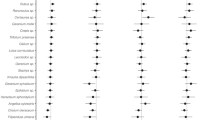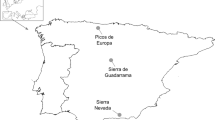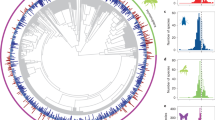Abstract
Pollinators are declining worldwide1 and this has raised concerns for a parallel decline in the essential pollination service they provide to both crops and wild plants2,3. Anthropogenic drivers linked to this decline include habitat changes, intensive agriculture, pesticides, invasive alien species, spread of pathogens and climate change1. Recently, the rapid global increase in artificial light at night4 has been proposed to be a new threat to terrestrial ecosystems; the consequences of this increase for ecosystem function are mostly unknown5,6. Here we show that artificial light at night disrupts nocturnal pollination networks and has negative consequences for plant reproductive success. In artificially illuminated plant–pollinator communities, nocturnal visits to plants were reduced by 62% compared to dark areas. Notably, this resulted in an overall 13% reduction in fruit set of a focal plant even though the plant also received numerous visits by diurnal pollinators. Furthermore, by merging diurnal and nocturnal pollination sub-networks, we show that the structure of these combined networks tends to facilitate the spread of the negative consequences of disrupted nocturnal pollination to daytime pollinator communities. Our findings demonstrate that artificial light at night is a threat to pollination and that the negative effects of artificial light at night on nocturnal pollination are predicted to propagate to the diurnal community, thereby aggravating the decline of the diurnal community. We provide perspectives on the functioning of plant–pollinator communities, showing that nocturnal pollinators are not redundant to diurnal communities and increasing our understanding of the human-induced decline in pollinators and their ecosystem service.
This is a preview of subscription content, access via your institution
Access options
Access Nature and 54 other Nature Portfolio journals
Get Nature+, our best-value online-access subscription
$29.99 / 30 days
cancel any time
Subscribe to this journal
Receive 51 print issues and online access
$199.00 per year
only $3.90 per issue
Buy this article
- Purchase on Springer Link
- Instant access to full article PDF
Prices may be subject to local taxes which are calculated during checkout




Similar content being viewed by others
References
Potts, S. G. et al. Safeguarding pollinators and their values to human well-being. Nature 540, 220–229 (2016)
Biesmeijer, J. C. et al. Parallel declines in pollinators and insect-pollinated plants in Britain and the Netherlands. Science 313, 351–354 (2006)
Clough, Y. et al. Density of insect-pollinated grassland plants decreases with increasing surrounding land-use intensity. Ecol. Lett. 17, 1168–1177 (2014)
Falchi, F. et al. The new world atlas of artificial night sky brightness. Sci. Adv. 2, e1600377 (2016)
Gaston, K. J., Gaston, S., Bennie, J. & Hopkins, J. Benefits and costs of artificial nighttime lighting of the environment. Environ. Rev. 23, 14–23 (2015)
Hölker, F., Wolter, C., Perkin, E. K. & Tockner, K. Light pollution as a biodiversity threat. Trends Ecol. Evol. 25, 681–682 (2010)
Ollerton, J., Winfree, R. & Tarrant, S. How many flowering plants are pollinated by animals? Oikos 120, 321–326 (2011)
Klein, A.-M . et al. Importance of pollinators in changing landscapes for world crops. Proc. R. Soc. B 274, 303–313 (2007)
Lautenbach, S., Seppelt, R., Liebscher, J. & Dormann, C. F. Spatial and temporal trends of global pollination benefit. Plos ONE 7, e35954 (2012)
MacGregor, C. J., Pocock, M. J. O., Fox, R. & Evans, D. M. Pollination by nocturnal Lepidoptera, and the effects of light pollution: a review. Ecol. Entomol. 40, 187–198 (2015)
Macgregor, C. J., Evans, D. M., Fox, R. & Pocock, M. J. O. The dark side of street lighting: impacts on moths and evidence for the disruption of nocturnal pollen transport. Glob. Change Biol. 23, 697–707 (2017)
Hölker, F. et al. The dark side of light: a transdisciplinary research agenda for light pollution policy. Ecol. Soc. 15, 13 (2010)
Gaston, K. J., Bennie, J., Davies, T. W. & Hopkins, J. The ecological impacts of nighttime light pollution: a mechanistic appraisal. Biol. Rev. Camb. Philos. Soc. 88, 912–927 (2013)
Hölker, F. et al. Microbial diversity and community respiration in freshwater sediments influenced by artificial light at night. Phil. Trans. R. Soc. B 370, 20140130 (2015)
Davies, T. W., Bennie, J. & Gaston, K. J. Street lighting changes the composition of invertebrate communities. Biol. Lett. 8, 764–767 (2012)
Spoelstra, K. et al. Experimental illumination of natural habitat—an experimental set-up to assess the direct and indirect ecological consequences of artificial light of different spectral composition. Phil. Trans. R. Soc. Lond. B 370, 20140129 (2015)
Gaston, K. J. & Bennie, J. Demographic effects of artificial nighttime lighting on animal populations. Environ. Rev. 22, 323–330 (2014)
Bascompte, J., Jordano, P., Melián, C. J. & Olesen, J. M. The nested assembly of plant–animal mutualistic networks. Proc. Natl Acad. Sci. USA 100, 9383–9387 (2003)
Thébault, E. & Fontaine, C. Stability of ecological communities and the architecture of mutualistic and trophic networks. Science 329, 853–856 (2010)
Vanbergen, A. J. et al. Grazing alters insect visitation networks and plant mating systems. Funct. Ecol. 28, 178–189 (2014)
Devoto, M., Bailey, S. & Memmott, J. The ‘night shift’: nocturnal pollen-transport networks in a boreal pine forest. Ecol. Entomol. 36, 25–35 (2011)
Waser, N. M., Chittka, L., Price, M. V., Williams, N. M. & Ollerton, J. Generalization in pollination systems, and why it matters. Ecology 77, 1043–1060 (1996)
Frank, K. D. in Ecological Consequences of Artificial Night Lighting (eds Rich, C. & Longcore, T. ) 305–344 (Island Press, 2006)
van Geffen, K. G., van Grunsven, R. H. A., van Ruijven, J., Berendse, F. & Veenendaal, E. M. Artificial light at night causes diapause inhibition and sex-specific life history changes in a moth. Ecol. Evol. 4, 2082–2089 (2014)
Bennie, J., Davies, T. W., Cruse, D. & Gaston, K. J. Ecological effects of artificial light at night on wild plants. J. Ecol. 104, 611–620 (2016)
Bersier, L. F., Banasek-Richter, C. & Cattin, M. F. Quantitative descriptors of food-web matrices. Ecology 83, 2394–2407 (2002)
Fontaine, C., Dajoz, I., Meriguet, J. & Loreau, M. Functional diversity of plant–pollinator interaction webs enhances the persistence of plant communities. PLoS Biol. 4, e1 (2006)
Vallejo-Marin, M., Dorken, M. E. & Barrett, S. C. H. The ecological and evolutionary consequences of clonality for plant mating. Ann. Rev. Ecol. Evol. Syst. 41, 193–213 (2010)
Fontaine, C. et al. The ecological and evolutionary implications of merging different types of networks. Ecol. Lett. 14, 1170–1181 (2011)
Gibson, R. H., Knott, B., Eberlein, T. & Memmott, J. Sampling method influences the structure of plant–pollinator networks. Oikos 120, 822–831 (2011)
Orford, K. A ., Vaughan, I. P. & Memmott, J. The forgotten flies: the importance of non-syrphid Diptera as pollinators. Proc. R. Soc. B 282, 20142934 (2015)
Rader, R. et al. Non-bee insects are important contributors to global crop pollination. Proc. Natl Acad. Sci. USA 113, 146–151 (2016)
Müller, C. B., Adriaanse, I. C. T., Belshaw, R. & Godfray, H. C. J. The structure of an aphid–parasitoid community. J. Anim. Ecol. 68, 346–370 (1999)
Sauve, A. M. C., Thébault, E., Pocock, M. J. O. & Fontaine, C. How plants connect pollination and herbivory networks and their contribution to community stability. Ecology 97, 908–917 (2016)
Vázquez, D. P., Chacoff, N. P. & Cagnolo, L. Evaluating multiple determinants of the structure of plant–animal mutualistic networks. Ecology 90, 2039–2046 (2009)
Acknowledgements
We thank all those who assisted with fieldwork, E. Thébault for discussions, M. Visser and M. Menz for comments that helped to improve this manuscript and D. Sanders for contributing to early ideas on the project. Furthermore, we are grateful to all experts who helped with identification of species: H.-P. Wymann (Lepidoptera), E. Obrecht (Diptera), S. Oertli (Hymenoptera) and C. Germann (Coleoptera). This study was supported by the Swiss National Sciences Foundation.
Author information
Authors and Affiliations
Contributions
E.K. and C.F. conceived the study and analysed the data. E.K., R.R., C.G. and L.Z. developed the set-up of the field sites and protocols. E.K., C.G., R.R., M.H. and L.Z. obtained the samples. E.K. wrote the first manuscript draft and all authors reviewed the manuscript.
Corresponding author
Ethics declarations
Competing interests
The authors declare no competing financial interests.
Additional information
Reviewer Information Nature thanks M. Devoto, J. Memmott and A. J. Vanbergen for their contribution to the peer review of this work.
Publisher's note: Springer Nature remains neutral with regard to jurisdictional claims in published maps and institutional affiliations.
Extended data figures and tables
Extended Data Figure 1 Accumulation curves for the species richness of flower visitors on illuminated and dark sites.
For each site 500 randomizations were performed and 95% confidence intervals are given (illuminated sites in white, dark sites in grey). Numbers above the plots correspond to the number of the pair of sites (see Supplementary Table 1).
Extended Data Figure 2 Accumulation curves for generalism of plant species on illuminated and dark sites.
For each site 500 randomizations were performed and 95% confidence intervals are given (illuminated sites in white, dark sites in grey). Numbers above the plots correspond to the number of the pair of sites (see Supplementary Table 1).
Extended Data Figure 3 Accumulation curves for generalism of flower visitors on illuminated and dark sites.
For each site 500 randomizations were performed and 95% confidence intervals are given (illuminated sites in white, dark sites in grey). Numbers above the plots correspond to the number of the pair of sites (see Supplementary Table 1).
Supplementary information
Supplementary Tables
This file contains Supplementary Tables 1-3. (PDF 882 kb)
Rights and permissions
About this article
Cite this article
Knop, E., Zoller, L., Ryser, R. et al. Artificial light at night as a new threat to pollination. Nature 548, 206–209 (2017). https://doi.org/10.1038/nature23288
Received:
Accepted:
Published:
Issue Date:
DOI: https://doi.org/10.1038/nature23288
This article is cited by
-
Artificial light at night reduces earthworm activity but increases growth of invasive ragweed
BMC Ecology and Evolution (2024)
-
Addition of nocturnal pollinators modifies the structure of pollination networks
Scientific Reports (2024)
-
Habitat and nutrients, but not artificial lighting at night, drive fish assemblage composition in urban streams
Urban Ecosystems (2024)
-
Crickets in the spotlight: exploring the impact of light on circadian behavior
Journal of Comparative Physiology A (2024)
-
Behaviour and landscape contexts determine the effects of artificial light on two crepuscular bird species
Landscape Ecology (2024)
Comments
By submitting a comment you agree to abide by our Terms and Community Guidelines. If you find something abusive or that does not comply with our terms or guidelines please flag it as inappropriate.



